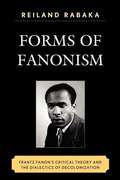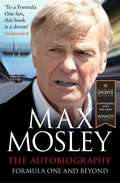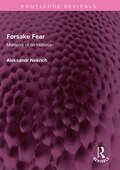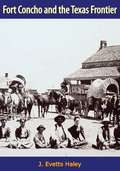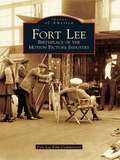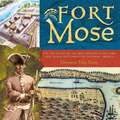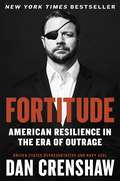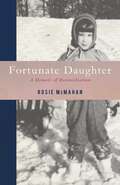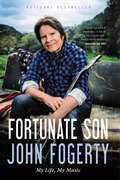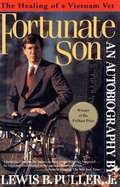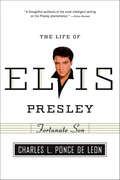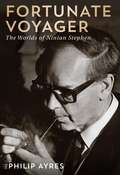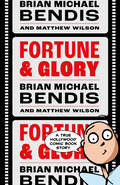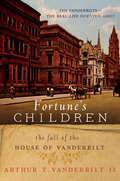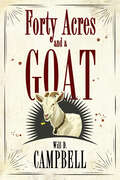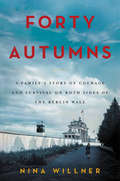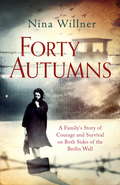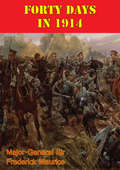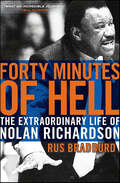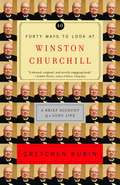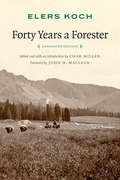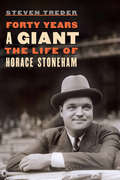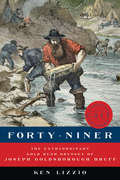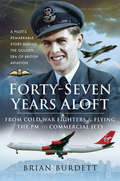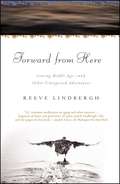- Table View
- List View
Forms of Fanonism: Frantz Fanon's Critical Theory and the Dialectics of Decolonization
by Reiland RabakaThis book, solemnly keeps with Fanon's own predilection for connecting critical theory to revolutionary praxis by utilizing his thought and texts as paradigms and points of departure to deepen and develop the Africana tradition of critical theory.
Formula One and Beyond
by Max MosleyFor almost 50 years, Max Mosley has been involved in motor racing, having seen the sport at all levels: as a driver, a team owner (with March) and, between 1993 and 2009, as President of the FIA, motor sport's governing body. In partnership wih Bernie Ecclestone, he helped transform Formula One into a multi-billion-pound global brand. Now, in this fascinating and revealing memoir, Mosley gives a compelling insight into the sport and its most influential figures and biggest stars - it is a book that no fan of Formula One can afford not to read. But Mosley's story goes far beyond motor sport, as his life and career have taken him through an extraordinary range of experiences, from being brought up as the son of Oswald and Diana Mosley, who were interned during the war, and having to deal with the taint of the family name; through his vital campaigns for road safety that have helped to save many thousands of lives; and on to the recent intrusions into his private life that led to a famous court case against the Murdoch press. It is a book that sheds new light on events from Formula One through to Ecclestone's controversial donation of a million pound to the Labour party. It is packed with behind-the-scenes gossip, vital business tips and some hilarious stories.
Forsake Fear: Memoirs of an Historian (Routledge Revivals)
by Aleksandr M NekrichFirst published in 1991, Forsake Fear is the history of historians in post-war Soviet society. Nekrich, in recounting his own brave story, tells us how he dared to challenge the prevailing conformism. From his unique ad riveting vantage point, Nekrich also provides a broader picture of Soviet society and its intellectual life during high Stalinism and after. In 1945, Aleksandr Nekrich returned from the front. He spent the next three decades at the centre of the Soviet historical profession. He maintained friendships with such noted public figures such as Ivan Maisky, Soviet ambassador to Britain, and Abram Deborin, whom Stalin branded a ‘Menshevik-idealist.’ He also encountered writers, artists, scientists, and even spies. Among Soviet historians, Nekrich was the only one who dared to break the taboo and declare that the Stalin-Hitler pact was advantageous to Nazi Germany. This book will be of interest to students of history, literature, international relations, and political science.
Fort Concho and the Texas Frontier
by J. Evetts HaleyThis book, which was first published in 1952, first began as a history of San Angelo and the adjacent region drained by the Conchos rivers. It grew, in writing, into a history of West Texas. It embodies author J. Evetts Haley’s unequaled knowledge of the country from the Rio Grande to the Canadian, from San Antonio and Austin to the border of New Mexico.It could have been written only by a man familiar by personal acquaintance with the location of every water hole and spring, the exploration of every trail from Coronado’s to the Overland Mail, the great cattle drives of the seventies and eighties, the establishment of every military post, and the shifting Indian policies of the United States from the annexation of Texas to the final retirement of the Comanches to the Indian Territory (now Oklahoma). Haley has an intimate knowledge of hundreds of salty characters who played their picturesque roles in transforming the land from nature to civilization.Haley possesses all this equipment—gained from intensive study, personal experience, and thoughtful reflection—for writing a vivid story. Five previous books and unnumbered articles on phases of the region contribute to the facility with which he tells this stirring tale and account of its comprehensiveness. It is no less than a history of West Texas in its heroic age.
Fort Lee: Birthplace of the Motion Picture Industry
by Fort Lee Film CommissionA favorite locale of such film pioneers as D. W. Griffith and Mary Pickford, the historic borough of Fort Lee was the first center of the American motion picture industry. Studios lined both sides of Main Street, and enormous film laboratories fed the nickelodeon market with thousands of reels of comedies and cliffhangers. Broadway stars and producers came here to make many of their first feature-length films; but by the 1920s, Theda Bara, Fatty Arbuckle, and Douglas Fairbanks were gone. Yet even after the studios closed down, the film industry was still the backbone of the local economy, with hundreds working behind the scenes in the printing, storage, and distribution of movies being made in Hollywood.
Fort Mosé: And the Story of the Man Who Built the First Free Black Settlement in Colonial America
by Glennette Tilley TurnerIn this one-of-a-kind historical picture book, author Glennette Tilley Turner tells the story of Fort Mose, which was founded in St. Augustine, Florida, and was the first free African settlement to legally exist in what later became the United States. Fort Mose was not only the first free black settlement, but it was also the most southern link of the Underground Railroad as a haven of refuge, just as cities in Canada were the northern most link Beginning with the story of Francisco Menendez, the Captain of the Black Militia of St. Augustine, FORT MOSE follows the history of slavery from West Africa to America, recounts what daily life was like, and describes the founding of the Spanish colony's Fort Mose. Established in 1738, Fort Mose gave sanctuary to escaped Africans, challenging slavery in the English colonies. Approximately one hundred Africans lived together, creating a frontier community that drew on a range of African backgrounds, blending them with those of Spanish, Native American, and English people and cultural traditions.
Fortitude: American Resilience in the Era of Outrage
by Dan CrenshawJordan Peterson's Twelve Rules for Life meets Jocko Willink and Leif Babin's Extreme Ownership in this tough-love leadership book from a Navy SEAL and rising star in Republican politics. <P><P>In 2012, on his third tour of duty in Afghanistan, an improvised explosive device left Dan Crenshaw's right eye destroyed and his left blinded. Only through the careful hand of his surgeons, and what doctors called a miracle, did Crenshaw's left eye recover partial vision. roadside And yet, he persevered, completing two more deployments. Why? There are certain stories we tell ourselves about the hardships we face - we can become paralyzed by adversity or we can adapt and overcome. We can be fragile or we can find our fortitude. Crenshaw delivers a set of lessons to help you do just that. Most people's everyday challenges aren't as extreme as surviving combat, and yet our society is more fragile than ever: exploding with outrage, drowning in microaggressions, and devolving into divisive mob politics. The American spirit -long characterized by grit and fortitude - is unraveling. We must fix it. <P><P>That's exactly what Crenshaw accomplishes with FORTITUDE. This book isn't about the problem, it's about the solution. And that solution begins with each and every one of us. We must all lighten up, toughen up, and begin treating our fellow Americans with respect and grace. FORTITUDE is a no-nonsense advice book for finding the strength to deal with everything from menial daily frustrations to truly difficult challenges. More than that, it is a roadmap for a more resilient American culture. <P><P>With meditations on perseverance, failure, and finding much-needed heroes, the book is the antidote for a prevailing "safety culture" of trigger warnings and safe spaces. Interspersed with lessons from history and psychology is Crenshaw's own story of how an average American kid from the Houston suburbs went from war zones to the halls of Congress-and managed to navigate his path with a sense of humor and an even greater sense that, no matter what anyone else around us says or does, we are in control of our own destiny. <P><P><b>A New York Times Bestseller</b>
Fortunate Daughter: A Memoir of Reconciliation
by Rosie McMahanRosie&’s sins were never difficult to recall; they lined themselves up like baby ducks in her mind&’s eye. Her confession to Father Hart one day in 1974 went like this: &“I didn&’t finish all my chores. I stole the Halloween candy my mom hid in the pantry. And I let my Daddy touch my private places.&” Though it begins as an all-too-common story of childhood sexual abuse, Fortunate Daughter gradually becomes a rare story of how one person heals from that early trauma. In this intimate first-person narrative, Rosie McMahan offers the reader a portrait of misery, abuse, and hurt, followed by the difficult and painful task of healing—a journey that, in the end, reveals the complicated and nuanced venture of true reconciliation and the freedom that comes along with it.
Fortunate Son: My Life, My Music
by John FogertyThe long-awaited memoir from John Fogerty, the legendary singer-songwriter and creative force behind Creedence Clearwater Revival.Creedence Clearwater Revival is one of the most important and beloved bands in the history of rock, and John Fogerty wrote, sang, and produced their instantly recognizable classics: "Proud Mary," "Bad Moon Rising," "Born on the Bayou," and more. Now he reveals how he brought CCR to number one in the world, eclipsing even the Beatles in 1969. By the next year, though, Creedence was falling apart; their amazing, enduring success exploded and faded in just a few short years. FORTUNATE SON takes readers from Fogerty's Northern California roots, through Creedence's success and the retreat from music and public life, to his hard-won revival as a solo artist who finally found love.
Fortunate Son: The Autobiography of Lewis B. Puller, Jr.
by Lewis B. PullerLewis B. Puller, Jr., the son of the most decorated Marine in the Corps' history, volunteered for duty in Vietnam after college. He came home a few months later missing both legs, his left hand, and two fingers of his right hand. He would never walk again, though he would complete law school, serve on President Ford's clemency board, and run for Congress. He would also live with the nightmares of Vietnam, and his growing dependence on alcohol. Few have told their story with more honesty, or more devastating openness.<P><P> Pulitzer Prize Winner
Fortunate Son: The Life of Elvis Presley
by Charles L. Ponce de LeonElvis Presley was celebrity's perfect storm. His sole but substantial contribution was talent, a fact Charles L. Ponce de Leon is careful to demonstrate throughout his wonderfully contextual Fortunate Son. Even as the moments of lucidity necessary to exercise that talent grew rarer and rarer, Elvis proved his musical gifts right up to the end of his life. Beyond that, however, he was fortune's child. Fortunate Son succinctly traces out the larger shifts that repeatedly redefined the cultural landscape during the 1950s, 1960s, and 1970s, using Elvis's life to present a brief history of American popular culture during these tumultuous decades.
Fortunate Voyager: The Worlds of Ninian Stephen
by Philip AyresOne life, many roles: soldier, brilliant barrister, High Court judge, Governor-General, Australian diplomat, mediator in Northern Ireland, member of the first war crimes tribunal since Nuremburg and Tokyo, head of UN and Commonwealth missions to crisis zones from Cambodia to Burma to Bangladesh, Sir Ninian Stephen is the recipient of five knighthoods and the most honoured Australian in history - and yet precisely because so much of his work was international it has rarely received the notice it deserves in his home country. In this, the first whole-of-life biography of the subject, Philip Ayres traces Stephen's early life in Scotland, England and around continental Europe, from Edinburgh and the Highlands to the spa towns of France and Germany, from the ski runs above Montreux to the Nuremberg Rally of 1938, including the details of his education at outstanding British and Swiss schools and his highly unorthodox "family" life as an only child with an absent father, the details of which, like so much here, have never previously been revealed. All this constitutes the unknown Ninian Stephen, and yet so much else in this book is new: the wartime Stephen, the barrister Stephen, and all the other aspects of his life traced in precise yet dramatic detail in a book whose momentum is generated through unique access to the full resources of the subject's personal papers.
Fortune and Glory Volume 1
by Brian Michael BendisBrian Michael Bendis, the New York Times bestselling, Peabody and multi-Eisner award-winning co-creator of Miles Morales, Naomi, Jessica Jones, and POWERS tells a comedic life lesson about the horrors of Hollywood.Before his acclaimed relaunches of Superman, Action Comics, and Young Justice...before his triumphant successes with Daredevil, Ultimate Spider-Man, Invincible Iron Man, and Jessica Jones...before his groundbreaking original series Powers, Scarlet, Cover, and Pearl......Brian Michael Bendis was a hungry young cartoonist about to take his first step into the shark-filled swimming pool that is the American motion picture industry. The harsh lessons that he learned along the way—and the unforgettable people that he met—are set down for the ages in Fortune and Glory, his hilarious autobiographical account of Hollywood development hell.Written and illustrated by Bendis and colored by Matthew Wilson, Fortune and Glory invites readers to gaze in wonder at the dizzying varieties of stupidity displayed by studio executives, and to share in the enthralling mood swings and ego nosedives of a small-time comic book creator as he rides the emotional roller coaster of freelance film production.This comprehensive trade paperback edition includes the complete story from the original three-issue miniseries and features an introduction from comics and animation legend Paul Dini as well as a wealth of promotional art and interviews straight from Bendis' archives. Collects Fortune and Glory #1–#3.
Fortune's Children
by Arthur T. Vanderbilt IIVanderbilt: the very name signifies wealth. The family patriarch, "the Commodore," built up a fortune that made him the world's richest man by 1877. Yet, less than fifty years after the Commodore's death, one of his direct descendants died penniless, and no Vanderbilt was counted among the world's richest people. Fortune's Children tells the dramatic story of all the amazingly colorful spenders who dissipated such a vast inheritance.
Forty Acres and a Goat (Banner Books)
by Will D. CampbellIn Forty Acres and a Goat, Will D. Campbell (1924–2013) picks up where the award-winning Brother to a Dragonfly leaves off, accounting his adventures during the tumultuous civil rights era. As he navigates through the explosive 1960s, including pivotal moments like the integration of Little Rock High School and the assassination of Dr. Martin Luther King Jr., Brother Will finds his faith challenged. To further complicate matters, a series of jobs did not pan out as expected—pastorate in Louisiana, director of religious life at the University of Mississippi, and with the National Council of Churches—leaving Brother Will “with a call but no steeple.” In an effort to find his place as a preacher, he moves his family to a farm in rural Tennessee and fashions his own unique style of ministry and a maverick relationship with God, land, and all his fellow pilgrims.
Forty Autumns: A Family's Story of Courage and Survival on Both Sides of the Berlin Wall
by Nina WillnerIn this illuminating and deeply moving memoir, a former American military intelligence officer goes beyond traditional Cold War espionage tales to tell the true story of her family--of five women separated by the Iron Curtain for more than forty years, and their miraculous reunion after the fall of the Berlin Wall.Forty Autumns makes visceral the pain and longing of one family forced to live apart in a world divided by two. At twenty, Hanna escaped from East to West Germany. But the price of freedom--leaving behind her parents, eight siblings, and family home--was heartbreaking. Uprooted, Hanna eventually moved to America, where she settled down with her husband and had children of her own. Growing up near Washington, D.C., Hanna's daughter, Nina Willner became the first female Army Intelligence Officer to lead sensitive intelligence operations in East Berlin at the height of the Cold War. Though only a few miles separated American Nina and her German relatives--grandmother Oma, Aunt Heidi, and cousin, Cordula, a member of the East German Olympic training team--a bitter political war kept them apart. In Forty Autumns, Nina recounts her family's story--five ordinary lives buffeted by circumstances beyond their control. She takes us deep into the tumultuous and terrifying world of East Germany under Communist rule, revealing both the cruel reality her relatives endured and her own experiences as an intelligence officer, running secret operations behind the Berlin Wall that put her life at risk. A personal look at a tenuous era that divided a city and a nation, and continues to haunt us, Forty Autumns is an intimate and beautifully written story of courage, resilience, and love--of five women whose spirits could not be broken, and who fought to preserve what matters most: family. Forty Autumns is illustrated with dozens of black-and-white and color photographs.
Forty Autumns: A family's story of courage and survival on both sides of the Berlin Wall
by Nina WillnerIn Forty Autumns, Nina Willner recounts the history of three generations of her family - mothers, sisters, daughters and cousins - separated by forty years of Soviet rule, and reunited after the fall of the Berlin Wall.Shortly after the end of the Second World War, as the Soviets took control of the eastern part of Germany, Hanna, a schoolteacher's daughter, escaped with nothing more than a small suitcase and the clothes on her back. As Hanna built a new life in the West, her relatives (her mother, father and eight siblings) remained in the East. The construction of the Berlin Wall severed all hope of any future reunion. Hanna fell in love and moved to America. She made many attempts to establish contact with her family, but most were unsuccessful. Her father was under close observation; her mother, younger sister Heidi and the others struggled to adjust to life under a bizarre and brutal regime that kept its citizens cut off from the outside world. A few years later, Hanna had a daughter - Nina - who grew up to become the first female US Army intelligence officer to lead sensitive intelligence collection operations in East Berlin at the height of the Cold War. At the same time, Heidi's daughter, Cordula, was training to become a member of the East German Olympic cycling team. Though separated by only a few miles, Nina and her relatives led entirely different lives. Once the Berlin Wall came down, and the families were reunited, Nina Willner discovered an extraordinary story. In Forty Autumns she vividly brings to life many accounts of courage and survival, set against the backdrop of four decades that divided a nation and the world.
Forty Days In 1914 [Illustrated Edition]
by Major-General Sir Frederick MauriceIncludes The First World War On The Western Front 1914-1915 Illustrations Pack with 101 maps, plans, and photos.In 1919 renowned military writer Major-General Sir Frederick Maurice set out to piece together how the German Schlieffen plan fell apart in the opening phases of the First World War. Using his extensive military background he deduced how the German High Command reacted to the opening clashes in 1914 and eventually recoiled after the Battle of the Marne. Still a fascinating read even after so many years, the details of the British and French commanders remain filled with the tension and drama as they sought to stem the seemingly unstoppable German juggernaut.
Forty Minutes of Hell: The Extraordinary Life of Nolan Richardson
by Rus Bradburd“Nolan Richardson’s extraordinary life and success as the University of Arkansas’ coach are an important chapter in the history of our country’s struggle for racial equality, with all the excitement of the Final Four. What an incredible journey!”—President Bill ClintonForty Minutes of Hell by Rus Bradburd is an intricate exploration of the politics of race and sports, from the Jim Crow era until today, witnessed through the life of legendary African-American basketball coach and NCAA Title winner Nolan Richardson. A remarkable story of pride, courage, and accomplishment in the face of discrimination, Forty Minutes of Hell is also a fascinating window into the world of elite collegiate sports. NBA legend Charles Barkley calls this inspiring and important biography, “A great story about America and its hidden histories….Every American should thank [Richardson] for showing us it was possible.”
Forty Ways to Look at Winston Churchill
by Gretchen RubinWarrior and writer, genius and crank, rider in the British cavalry's last great charge and inventor of the tank--Winston Churchill led Britain to fight alone against Nazi Germany in the fateful year of 1940 and set the standard for leading a democracy at war. Like no other portrait of its famous subject, Forty Ways to Look at Winston Churchill is a dazzling display of facts more improbable than fiction, and an investigation of the contradictions and complexities that haunt biography. Gretchen Craft Rubin gives readers, in a single volume, the kind of rounded view usually gained only by reading dozens of conventional biographies. With penetrating insight and vivid anecdotes, Rubin makes Churchill accessible and meaningful to twenty-first-century readers with forty contrasting views of the man: he was an alcoholic, he was not; he was an anachronism, he was a visionary; he was a racist, he was a humanitarian; he was the most quotable man in the history of the English language, he was a bore.In crisp, energetic language, Rubin creates a new form for presenting a great figure of history--and brings to full realization the depiction of a man too fabulous for any novelist to construct, too complicated for even the longest narrative to describe, and too valuable ever to be forgotten. From the Hardcover edition.
Forty Years a Forester: With "the Passing Of The Lolo Trail"
by Elers KochElers Koch, a key figure in the early days of the U.S. Forest Service, was among the first American-trained silviculturists, a pioneering forest manager, and a master firefighter. By horse and on foot, he helped establish the boundaries of most of our national forests in the West, designed new fire-control strategies and equipment, and served during the formative years of the agency. Forty Years a Forester, Koch’s entertaining and illuminating memoir, reveals one remarkable man’s contributions to the incipient science of forest management and his role in building the human relationships and policies that helped make the U.S. Forest Service, prior to World War II, the most respected bureau in the federal government. This new, fully annotated edition of Koch’s memoir offers an unparalleled look at the Forest Service’s formative ambitions to regulate the national forests and grasslands and reminds us of the principled commitment that Koch and his peers exemplified as they built the national forest system and nurtured the essential conservation ethic that continues to guide our use of the public lands.
Forty Years a Giant: The Life of Horace Stoneham
by Steven TrederWhen New York Giants owner Charles A. Stoneham came home one night in 1918 and told his teenage son, Horace, &“Horrie, I bought you a ballclub,&” he set in motion a family legacy. Horace Stoneham would become one of baseball&’s greatest figures, an owner who played an essential role in integrating the game, and who was a major force in making our pastime truly national by bringing Major League Baseball to the West Coast. Horace Stoneham began his tenure with the Giants in 1924, learning all sides of the operation until he moved into the front office. In 1936, when his father died of kidney disease, Horace assumed control of the Giants at age thirty-two, becoming one of the youngest owners in baseball history. Stoneham played a pivotal role in not just his team&’s history but the game itself. In the mid-1940s when the Pacific Coast League sought to gain Major League status, few but Stoneham and Branch Rickey took it seriously, and twelve years later the Giants and Dodgers were the first two teams to relocate west. Stoneham signed former Negro Leaguers Monte Irvin and Hank Thompson, making the Giants the second National League franchise to racially integrate. In the late 1940s, the Giants hired their first Spanish-speaking scout and soon became the leading team in developing Latin American players. Stoneham was shy and self-effacing and avoided the spotlight. His relationships with players were almost always strong, yet for all his leadership skills and baseball acumen, sustained success eluded most of his teams. In forty seasons his Giants won just five National League pennants and only one World Series. The Stoneham family business struggled, and the team was forced to sell off its beloved stars, first Willie Mays, then Willie McCovey, and finally Juan Marichal. Then Stoneham had no choice but to sell the club in 1975. While his tenure came to an unfortunate end, he is heralded as a pioneer and leader whose story tells much of baseball history from the 1930s through the 1970s.
Forty-Niner: The Extraordinary Gold Rush Odyssey Of Joseph Goldsborough Bruff (American Grit #0)
by Ken LizzioExperience the majesty and terror of the Gold Rush firsthand While the seminal California Gold Rush of 1849 produced numerous firsthand diaries and accounts, Joseph Goldsborough Bruff’s—widely regarded as the best and most accurate—provides the basis of this narrative reimagining of a quintessential American legend. Ken Lizzio traces the pioneer’s thrilling adventure from the first rumors of gold, through his crossing of the frontier, all the way to his incredible survival and escape to a prosperous life back east. This is the first book to create a narrative of Bruff’s journey from his meticulously written and preserved diary. And with more than fifty of Bruff’s original pencil sketches and paintings, Forty-Niner provides a new, immersive vision of one of America’s most fabled eras. The American Grit series brings you true tales of endurance, survival, and ingenuity from the annals of American history. These books focus on the trials of remarkable individuals with an emphasis on rich primary source material and artwork.
Forty-Seven Years Aloft: From Cold War Fighters & Flying the PM to Commercial Jets
by Brian Burdett&“A journey through 47 years of aviation history through the memories of one pilot. From . . . &‘antics&’ in jet fighters, and civil aviation to retirement.&” —Vintage Airfix It all began for London-born Brian Burdett, as it has for so many, with the Air Cadets, flying Tiger Moths at the age of just fourteen. He obtained his civil license at the age of seventeen, and six months later he was accepted into the RAF. The year was 1954. It was to fly Hunters that Brian was posted to 257 (Burma) Squadron at Wattisham in Suffolk, where the jets were frequently scrambled to intercept Soviet intruders in the dark days of the Cold War. His RAF career developed further with a transfer to Transport Command where Brian could fly the planes he loved the best—the big jets. After training on Handley Page Hastings, Brian was given the chance to fly the famous de Havilland on long-distance routes between the RAF bases around the world, through the Middle East, Pakistan, Sri Lanka and down to South Africa and Australasia. He eventually turned to the commercial world, flying Falcons, VC 10s, Tristars and every type of Boeing 747, for a variety of airlines. His adventures are legion. From a double engine failure on takeoff and still managing to land safely, to losing control in cloud and leveling off feet from the ground, to a midair near miss with an American aircraft that no-one knew was there, to spotting a strange object that remains unidentified to this day. &“A fascinating career in military aviation and commercial aviation spanning 47 years . . . Highly Recommended.&” —Firetrench
Forward From Here: Leaving Middle Age--and Other Unexpected Adventures
by Reeve LindberghIn her funny and wistful new book, Reeve Lindbergh contemplates entering a new stage in life, turning sixty, the period her mother, Anne Morrow Lindbergh, once described as "the youth of old age." It is a time of life, she writes, that produces some unexpected surprises. Age brings loss, but also love; disaster, but also delight. The second-graders Reeve taught many years ago are now middle-aged; her own children grow, marry, have children themselves. "Time flies," she observes, "but if I am willing to fly with it, then I can be airborne, too." A milestone birthday is also an opportunity to take stock of oneself, although such self-reflection may lead to nothing more than the realization, as Reeve puts it, "that I just seem to continue being me, the same person I was at twelve and at fifty." At sixty, as she observes, "all I really can do with the rest of my life is to...feel all of it, every bit of it, as much as I can for as long as I can." Age is only one of many subjects that Reeve writes about with perception and insight. In northern Vermont, nature is an integral part of daily life, especially on a farm. Whether it is the arrival and departure of certain birds in spring and fall, wandering turtles, or the springtime ritual of lambing, the natural world is a constant revelation. With a wry sense of humor, Reeve contemplates the infirmities of the aging body, as well as the many new drugs that treat these maladies. Briefly considering the risks of drug dependency, she writes that "the least we [the "Sixties Generation"] can do for ourselves is live up to our mythology, and take lots of drugs." Legal drugs, that is -- although what sustains us as we grow older is not drugs but an appreciation for life, augmented by compassion, a sense of humor, and common sense. And of course there is family -- especially with the Lindberghs. Reeve writes about discovering, thirty years after her father's death and two and a half years after her mother's, that her father had three secret families in Europe. She travels to meet them, learning to expand her self-understanding: "daughter of," "mother of," "sister of" -- sister of many more siblings than she'd known, in a family more complicated than even she had imagined. Forward from Here is a brave book, a reflective book, a funny book -- a book that will charm and fascinate anyone on the journey from middle age to the uncertain future that lies ahead.
